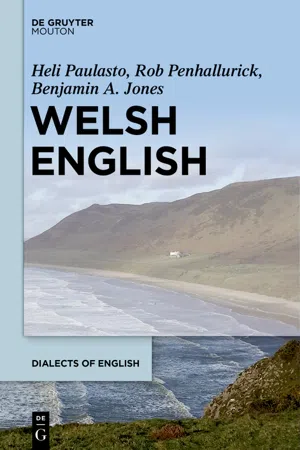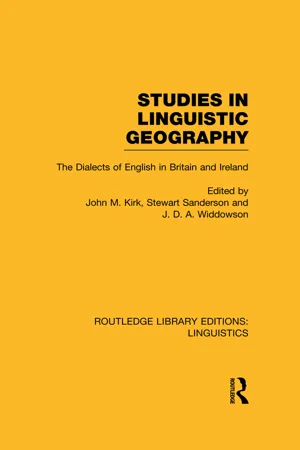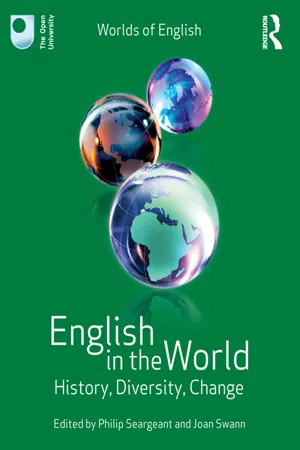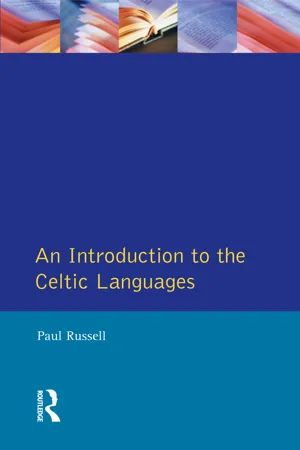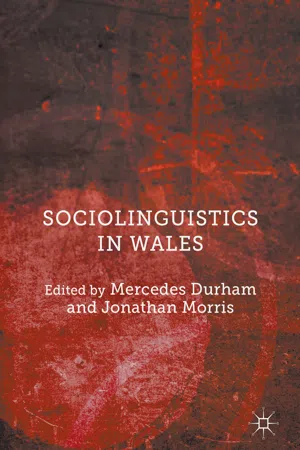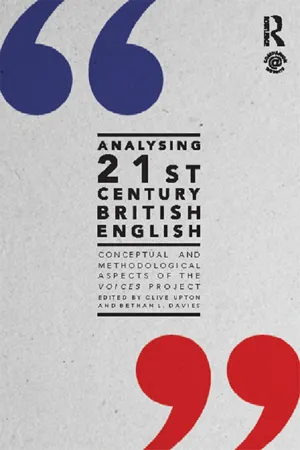Languages & Linguistics
Welsh English
Welsh English refers to the variety of English spoken in Wales, influenced by the Welsh language and its phonology, vocabulary, and grammar. It is characterized by a distinct accent and certain linguistic features that set it apart from other forms of English. Welsh English reflects the cultural and historical interactions between the Welsh and English languages within Wales.
Written by Perlego with AI-assistance
Related key terms
Related key terms
1 of 4
Related key terms
1 of 3
7 Key excerpts on "Welsh English"
- eBook - ePub
- Heli Paulasto, Rob Penhallurick, Benjamin Jones(Authors)
- 2020(Publication Date)
- De Gruyter Mouton(Publisher)
Wenglish: The Dialect of the South Wales Valleys (2008) by Robert Lewis. As the titles may indicate, neither book approaches its subject purely academically but is intended for the enlightenment and entertainment of the general public. The glossaries in the books are long and comprehensive, containing not only dialect words of Welsh and English origin, but also expressions and idioms, nonstandard grammar items and regionally distinctive pronunciations of specific words. As such, they offer an interesting window into the dialect of the Valleys, coloured by the region’s bilingual past as an industrial hotspot. Both Edwards and Lewis are local to the area, which is an advantage but also a problem, as they base their glossaries and descriptions on their own knowledge and experience of the dialect rather than systematic data collection or corpus evidence: no further references or sources of information are given. The glossaries are also uninformative on the frequencies and time frames of the words, and thus it is likely that there is a great deal of quantitative, regional and diachronic variation in their actual use. The authors do not contextualize “Wenglish” or its features as part of English in Wales more generally but present it as an independent development.Welsh English Dialect (Jones 2016a) is likewise intended for a wide audience, and although concise, it is more systematic in its approach and regionally comprehensive. Besides a general word list, the booklet includes lexical case studies and thematic sections on, for example, the language of children’s games, food, work, music, and the home, as well as WelE phraseology.WelE dialect lexicon has recently been charted alongside EngE dialects, in the BBC Voices project (BBC Voices 2014) through an online “Language Lab” survey and a radio survey (2004–2005; see Penhallurick 2013). The Language Lab results are available in the form of lexical maps at the BBC Voices website. The Voices radio survey, in turn, involved groups of informants who were gathered together to discuss the topic of dialects and accents in various parts of the country. They were furthermore presented with a list of lexical items, and the outcomes of the discussions have been worked into linguistic commentaries which are availed of in the present description (see Section 1.6 and Chapter 6). The Voices - eBook - ePub
- Alexander Bergs, Laurel Brinton, Alexander Bergs, Laurel Brinton(Authors)
- 2017(Publication Date)
- De Gruyter Mouton(Publisher)
per se . In her consideration of the field, Löffler (2008) has cautioned that although the “Welsh Englishes” are an acknowledged feature of the sociolinguistic situation in Wales, their social role is neither clear-cut nor simple.Borrowings from Welsh into English from the 17th century onwards relate mainly to aspects of Welsh culture and an illustrative list will suffice here. They include tad or dad , father; cromlech an ‘arched stone’ a megalithic chamber tomb or dolmen; englyn , a four-lined stanza of prescribed from written in cynghanedd metre; flummery , a pudding made with coagulated wheatflour or oatmeal, which has come to mean flattery or nonsense; Gorsedd , a ‘throne’ a meeting of bards and druids; cynghannedd , a complex form of alliterative metre; cwm , a valley; a deep rounded hollow with a steep side formed by ice action; a cirque; eisteddfod , ‘session’ a festival of poetry, singing, music the arts and increasingly technology; hwyl , emotional fervor, characteristic of poetry recitation, and corgi , ‘dwarf-dog’ short-legged dogs from either Cardigan or Pembroke as favored by the British Royal Family (Helcion 1998).Finally, it is important not to over-compartmentalize Welsh and English in Wales, because code-switching is a common characteristic of bilingual usage. Research by Deuchar (2006) and Deuchar et al. (2007, 2016, 2017) for example, has evaluated universal and conditional models of code switching. Stammers and Deuchar (2007) have analyzed English verbs in Welsh speech by reference to generic hypotheses suggested by Poplack and Meechan (1998) and Myers-Scotton (1993) and concluded that frequency may be more important than contrast between switches and loans. Deuchar (2006) also argues that Welsh-English speakers in her data tend to maintain a Welsh-language matrix in their code-switched speech, and consequently that they are comparable to Spanish-English speakers in the USA, or Arabic-Dutch speakers in the Netherlands. This in turn suggests a pattern of bilingual communication typical of relatively stable bilingual contexts, rather than one that presages language shift or language death. Musk (2010) takes a different perspective, providing evidence that Welsh-English bilinguals tend to blend their codes into a relatively syncretic and flexible communication system. Codes are kept separate only for specific discursive purposes, such as quoting other people’s utterances. - eBook - ePub
Studies in Linguistic Geography (RLE Linguistics D: English Linguistics)
The Dialects of English in Britain and Ireland
- John M. Kirk, Stewart Sanderson, J.D.A. Widdowson(Authors)
- 2014(Publication Date)
- Routledge(Publisher)
vice versa. Occasionally sermons can be heard in which each section of discourse is first given in Welsh, then repeated or summarised in English, and some village-square conversations appear to be constructed according to a similar pattern. One Carmarthenshire-born husband and his Merioneth-born wife speak to each other only in English because, they say, each finds difficulty in the other’s dialect of the native tongue. Any A.J. Ellis-type Celtic boundary designed to show the linguistic preferences even of just our informants would be hard to draw and would require complex annotation. Perhaps even when all the available documents on bilingualism in Wales have been consulted, one may be unable to do more than quote bilingual informants’ own assertions about their linguistic habits (noted by the fieldworkers) and try one’s best to fit these into the broader picture that the documents suggest.Informants in some localities gave a good many Welsh words in response to the Questionnaire, but SAWD of course is concerned with Welsh only in so far as it influenced the English spoken in the Principality. Welsh sounds used in pronouncing English, and Welsh-derived syntactical constructions, are easily recognised and there is no doubt about their status: they are not Welsh but Anglo-Welsh. Welsh words given as responses to questions designed to elicit AW pronunciation and grammar can of course be categorically ignored. But the same cannot be said of Welsh words given in responses to questions designed to elicit AW lexis. On the one hand they may be just ‘intruders’ — by which I mean ‘Welsh words given by an informant who merely draws on his Welsh word-stock to fill gaps in his English one’: from the investigator’s point of view the informant is answering in a foreign language, one already documented in Alan Thomas’s The Linguistic Geography of Wales (Thomas 1973). On the other hand, a proffered Welsh word may be a genuine importation into the AW dialect of the locality: one might cite as examples the continuing currency of twp ‘stupid’, pentan ‘the hob of a grate’, ach-y-fi! (an exclamation of disgust) in Gwent, the Gower Peninsula, and other areas that have long been English-speaking. Here the language is so unarguably a dialect of English that no one need hesitate to accord such words the status of completely-established ‘Welsh loans into Anglo-Welsh’ and proper material for inclusion in the atlas. The difficulty lies in deciding the status to be accorded Welsh lexical items in the bilingual areas. No general principle suggests itself, but where an informant gave both a Welsh word and an English one we shall generally (not invariably — see below) ignore the former and map the latter, even if we suspect this latter to be just the English translation (learnt from school, dictionary, radio, and so on) that came most readily to the informant’s mind: here of course is where the informants’ assertions about their own linguistic backgrounds and preferences may help us assess the status not only of their Welsh words but also sometimes of their English ones. But where a Welsh word was the sole elicited response it will have to be accepted, faute de mieux - eBook - ePub
English in the World
History, Diversity, Change
- Philip Seargeant, Joan Swann, Philip Seargeant, Joan Swann(Authors)
- 2013(Publication Date)
- Routledge(Publisher)
he’s going …) is largely confined to late anglicisation areas and can be connected to the influence of Welsh.Finally, the influence of the Welsh language is said to be particularly evident in prosody (a feature of pronunciation that includes stress, rhythm, intonation, etc.). John Wells (1982, p. 392) notes that ‘[p]opular English views about Welsh accents include the claim that they have a “sing-song” or lilting intonation’ and this may have substance in linguistic analysis: the vowel in the final unstressed syllable for words such as sofa and butter is lengthened and has a fuller quality when compared to standard English in England, and this may be perceived as melodic. This is attributed to the Welsh language, where final unstressed syllables are not reduced, and is a feature generally shared throughout Wales.The examples above provide a snapshot of the different influences on the development of English in Wales, and how these impact on present-day dialects of Welsh English.English in Ireland
The use of English in Ireland dates back to 1250, but just as in Wales, widespread use did not come about until much later, around the seventeenth century, with the organised colonisation of Ireland by the British Crown.Hickey (2007, p. 142) states that ‘it is obvious that linguistically, as well as politically, Ireland is divided into two broad sections, the north and the south’ and these are largely related to patterns of settlement. The broad dialect areas are shown in Figure 5.4 .Figure 5.4 Dialect areas in Ireland (Hickey, 2004)The northern area can be further divided into three major dialect regions which developed during the period of colonisation: Ulster Scots, derived from the Lowland Scots settlers; Mid-Ulster English, derived from settlers coming largely from northern England; and a variety spoken in the west of Donegal arising from forms of Ulster English in contact with Irish. Added to these three main varieties is the capital of Belfast, where a number of different varieties converge. - eBook - ePub
- Paul Russell(Author)
- 2014(Publication Date)
- Routledge(Publisher)
Chapter 5 Welsh5.0 Introduction
The linguistic situation of Welsh differs from that of Irish in that there are in Wales several registers of standard language beside the regional dialects.1 In Ireland, as we have seen in Chapter 3 , there is no widely accepted standard form. But, while for Irish numerous dialect descriptions are available, for Welsh there are few thorough descriptions of a single dialect in print.2 The following description, therefore, attempts to provide an account which does justice to the variation in the language. The phonology must necessarily concentrate on the spoken forms but in other sections attention is paid to the literary language. The description considers the language from the point of view of the traditional categories of phonology, morphology and syntax. It does not take a strong theoretical stance to the evidence but opportunity is taken, where appropriate, to consider studies of Welsh which have used specific theoretical viewpoints.5.1 Types of Welsh
It is a commonplace of language that native speakers have a wide range of registers at their disposal which they deploy in the appropriate contexts, and conversely that second language speakers find it difficult to distinguish registers and use them effectively. In any language a more formal register is likely to be used in talking to the bank manager than to one's best friend. The medium of communication can also have an effect; a written communication of any kind is likely to take up more time and therefore give more room for thought than a spoken conversation, but it can still take place in different registers. Native speakers are also adept at style-switching; Ball, Griffiths et al. - eBook - ePub
- Mercedes Durham, Jonathan Morris, Mercedes Durham, Jonathan Morris(Authors)
- 2017(Publication Date)
- Palgrave Macmillan(Publisher)
Journal of Sociolinguistics 11(1): 74–103.CrossRefCoupland, Nikolas, Angie Williams, and Peter Garrett. 1994. The social meanings of Welsh English: Teachers’ stereotyped judgements. Journal of Multilingual and Multicultural Development 15(6): 471–489. doi:10.1080/01434632.1994.9994585 .———. 1999. ‘Welshness’ and ‘Englishness’ as attitudinal dimensions of English language varieties in Wales. In Handbook of perceptual dialectology , vol 1, ed. Dennis R. Preston, 333–343. Amsterdam: John Benjamins.Cramer, Jennifer. 2010. The effect of borders on the linguistic production and perception of regional identity in Louisville, Kentucky. Unpublished PhD thesis, Urbana: University of Illinois at Urbana-Champaign. https://www.ideals.illinois.edu/bitstream/handle/2142/18426/Cramer_Jennifer.pdf?sequence=1Cukor-Avila, Patricia, Lisa Jeon, Patricia C. Rector, Chetan Tiwari and Zak Shelton. 2012. ‘Texas – It’s like a whole nuther country’: Mapping Texans’ perceptions of dialect variation in the Lone Star State. In Proceedings of the Twentieth Annual Symposium About Language and Society , 55: 10–19. Austin, TX.Davies, John. 2007. A history of Wales . London: Penguin.Department for Children, Education, Lifelong Learning and Skills. 2007. Defining schools according to Welsh medium provision . Cardiff: Welsh Assembly Government. http://gov.wales/topics/educationandskills/publications/guidance/defining-schools-welsh-medium/?lang=enDiercks, Willy. 2002. Mental maps: Linguistic geographic concepts. In Handbook of perceptual dialectology , ed. Daniel Long, and Dennis R. Preston, 51–70. Amsterdam: John Benjamins.Edwards, John. 2003. “Talk Tidy”: The art of speaking Wenglish . Creigiau: Tidyprint Publications. (First published in 1985, Cowbridge: Brown Books).Fought, Carmen. 2002. Californian students’ perceptions of, you know, regions and dialects? In Handbook of perceptual dialectology - eBook - ePub
Analysing 21st Century British English
Conceptual and Methodological Aspects of the 'Voices' Project
- Clive Upton, Bethan Davies(Authors)
- 2013(Publication Date)
- Routledge(Publisher)
Welsh English Syntax: Contact and Variation, Joensuu: Joensuu University Press.Penhallurick, R. J. (1991) The Anglo-Welsh Dialects of North Wales: A Survey of Conservative Rural Spoken English in the Counties of Gwynedd and Clwyd, Frankfurt am Main: Peter Lang.Robinson, J., Herring, J. and Gilbert, H. (2009–2012) Voices of the UK linguistic descriptions. Online. Available HTTP: <http://sounds.bl.uk/Accents-and-dialects/BBC-Voices >.Upton, C., Parry, D. and Widdowson, J. D. A. (1994) Survey of English Dialects: The Dictionary and Grammar, London/New York: Routledge.Wright, J. (ed.) (1902) The English Dialect Dictionary
Index pages curate the most relevant extracts from our library of academic textbooks. They’ve been created using an in-house natural language model (NLM), each adding context and meaning to key research topics.
Explore more topic indexes
Explore more topic indexes
1 of 6
Explore more topic indexes
1 of 4
